ADAMS后处理--如何把Adams后处理的图片编辑的漂亮
ADAMS操作基础
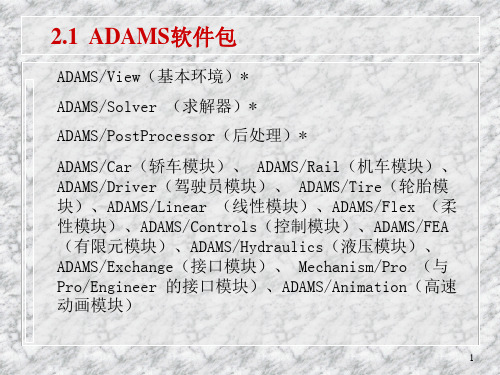
单位设置
单 位 系 统 长 度 质 量 力
1 MMKS 毫 米 公 斤 牛 顿
2 MKS
米 公 斤 牛 顿
3 CGS 厘 米 克 达 因
4 IPS 英 寸 斯 磅 力
时 间 角 度 频 率 秒 度 弧 度 /秒 秒 度 弧 度 /秒 秒 度 弧 度 /秒 秒 度 弧 度 /秒
定义重力
15
2.10 信息管理及帮助信息
1
2.2 虚拟样机仿真分析基本步骤
机械系统建模 : 几何建模、运动副和运动约束、载荷 仿真分析 仿真结果分析 :回放仿真结果、绘制仿真结果曲线 验证仿真分析结果 :实验数据 与实验结果一致 ? 精制机械系统模型 :摩擦力 、柔性物体和连接、控制 重复仿真分析 机械系统优化分析 :可变参数 、试验设计 、最优化
菜单栏、 弹出式菜单、
• 屏幕上的各种对象,例如:构件、标记、约束、运动、力等 • 输入对话框中的文本输入栏 • 后处理图标中的各种对象,例如:曲线、标题、坐标、符号标记
等
快捷工具栏 命令窗口
8
鼠标的应用
鼠标左键和鼠标右键
左键: 选择样机模型中的各种对象、选择菜单栏中的命 令、快捷工具图标命令和对话框中的有关命令。
3-2 输入ADAMS/View命令的常用方法有哪两种?试比较各 自的优缺点。
3-3 鼠标的右键操作主要应用于哪些场合? 3-4 *
17
虚拟样机技术入门与应用--3
虚拟样机建模
3.1 几何建模预备知识
几何体类型
• 4种类型的几何体:刚性形体、柔性形体、点质量和地基形体
几何体坐标系
• 每一个新产生的几何体都设有一个参考坐标---构件机架坐标系
• 动态移动视图 • 动态旋转视图
Adams软件后置处理

Adams后处理中测量曲线数据的查看与导出作者:Simwe 来源:MSC发布时间:2012-05-29 【收藏】【打印】复制连接【大中小】我来说两句:(1) 逛逛论坛你知道可以以列表的方式查看Adams/PostProcessor中显示的曲线图吗?另外,你可以将一个曲线以数据表的形式导出,也就是说,你能够利用曲线绘图来分类或创建用户自定义的输出文件。
1.Adams/PostProcessor中利用数据列表方式显示测量曲线左键选择一个曲线绘图边框,注意不要点击在曲线、图例或坐标轴上。
另一个方法是可以在Adams/Postprocessor左侧窗口的模型树中选择对应的曲线绘图,在这个过程中可能需要点击一个page前的+号以将page中的内容扩展开显示对应的曲线绘图。
当选择了一个曲线绘图后,注意在窗口左下角的属性编辑窗口中的Table复选框。
选择Table复选框后对应的属性编辑窗口将变为观察图表显示的控制窗口。
在视窗中原来的曲线绘图变为了HTML格式的图表数据。
下图例子中显示了单摆的X向和Y向位移。
2.Adams/PostProcessor中曲线数据导出方式在Adams/PostProcessor中,导出数据有三种方式:Numeric Data,Spreadsheet 和Table。
Numeric Data和Spreadsheet方式导出数据会导出整个结果集中包含的数据,Table方式导出数据只会导出在你所选择的曲线视图中显示的曲线数据。
例如,如果整个仿真时间为2秒,那么Numeric Data,Spreadsheet方式会导出完整的2秒钟内所有的数据点;那么如果你只想导出1秒钟的数据,那么你可以设定坐标横范围为0至1秒,如下图所示,然后利用Table方式导出数据。
File->Export->Table弹出对话框,在File Name中指定文件名称,将以后缀名".Tab"输出该文件,Plot域中指定那组数据需要输出;你可以直接输入曲线绘图的名称或通过Pick/Browse/Guess工具来找到对应的曲线绘图。
ADAMS系统测量与仿真和仿真后处理
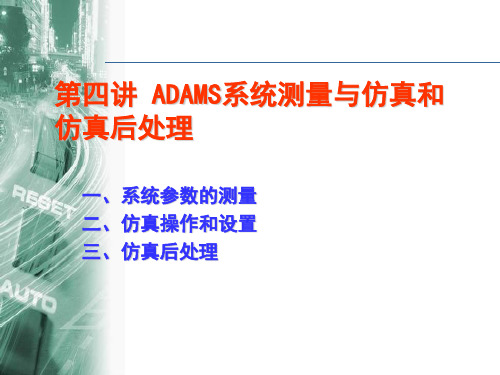
对象 结构 关系
栏
特性 编辑 区
工具条
后处理程序窗口
后处理的绘图 区
菜单栏 页面操 作区
控制面 板区 状态 栏
2、仿真模型的调入和仿真重 现
仿真模型调入:
I)激活拟显示虚拟样机仿真过程的屏 幕视窗,然后将鼠标置于视窗上, 打开弹出式菜单。
2)选择Load Animation命令,调入 ADAMS/View的仿真计算结果,可 以在屏幕上看见已经调入的样机。
名称 测量零件 测量特征 测量分量
测 量 构Ⅰ 件 对 话 框
Selected Object参数表示构件、运 动副、力、运动、点或标记等各种对
象的测量;
Point—to—Point参数表示两点之间 的相对运动测量;
Orientation参数表示坐标系标记方向 的测量;
Range 参数表示已定义的测量的统计值 ,例如:平均值、最大值等;
页的操作
操作工具
后
前新
删
翻
翻建
除
视窗的操作
视窗布置 选择视窗 放大视窗 转移视窗内容 删除视窗内容
对象结构关系及其转性编辑
Modeling项包括与仿真样机 有关的各种对象类型,例如 :构件、运动副、作用力等
Plotting项包括与绘制 数据曲线图有关的各种 对象类型,例如:曲线
、标题等。
重现仿真过程
数据曲线自变量坐标轴的选择
在控制面板右侧 的自变量轴选择 区(Independent
Axis),选择 Data项
在弹出的自变量 轴浏览对话框, 选择自变量轴(X 轴)的变量,然
后选择OK
修改坐标轴的特性
特性:坐标轴 的范围、颜色 、坐标刻度、 坐标刻度标记 、坐标标题和
adams后处理学习资料
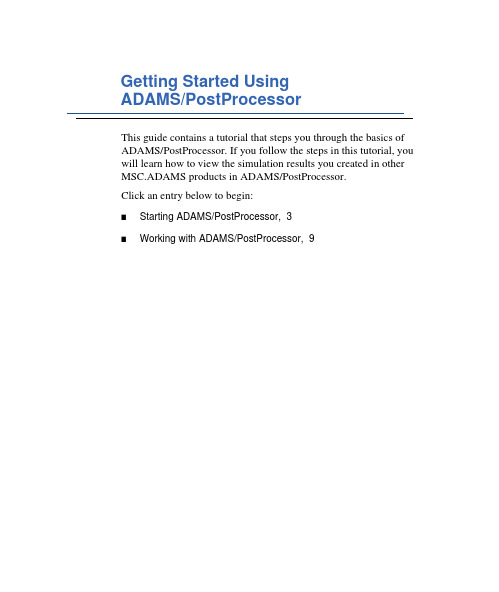
Getting Started UsingADAMS/PostProcessorThis guide contains a tutorial that steps you through the basics of ADAMS/PostProcessor. If you follow the steps in this tutorial, you will learn how to view the simulation results you created in other MSC.ADAMS products in ADAMS/PostProcessor.Click an entry below to begin:■Starting ADAMS/PostProcessor,3■Working with ADAMS/PostProcessor,9Getting Started Using ADAMS/PostProcessor 2CopyrightThe information in this document is furnished for informational use only, may be revised from time to time, and should not be construed as a commitment by MSC.Software Corporation. MSC.Software Corporation assumes no responsibility or liability for any errors or inaccuracies that may appear in this document.Copyright InformationThis document contains proprietary and copyrighted information. MSC.Software Corporation permits licensees of MSC.ADAMS software products to print out or copy this document or portions thereof solely for internal use in connection with the licensed software. No part of this document may be copied for any other purpose or distributed or translated into any other language without the prior written permission of MSC.Software Corporation.Copyright © 2004 MSC.Software Corporation. All rights reserved. Printed in the United States of America. TrademarksADAMS, EASY5, MSC, MSC., MSC.ADAMS, MSC.EASY5, and all product names in the MSC.ADAMS Product Line are trademarks or registered trademarks of MSC.Software Corporation and/or its subsidiaries.NASTRAN is a registered trademark of the National Aeronautics Space Administration. MSC.Nastran is an enhanced proprietary version developed and maintained by MSC.Software Corporation. All other trademarks are the property of their respective owners.Government UseUse, duplication, or disclosure by the U.S. Government is subject to restrictions as set forth in FAR 12.212 (Commercial Computer Software) and DFARS 227.7202 (Commercial Computer Software and Commercial Computer Software Documentation), as applicable.Starting ADAMS/PostProcessorOverviewWe’ve provided a tutorial that steps you through the basics ofADAMS/PostProcessor. If you follow the steps in this tutorial, youwill learn how to view the simulation results you created in otherMSC.ADAMS products in ADAMS/PostProcessor. The sections inthe chapter are:■What You Will Do in the Tutorial, 4■Starting ADAMS/PostProcessor, 4■Loading the Simulation Results, 5The tutorial takes about 20 minutes to complete.Getting Started Using ADAMS/PostProcessor 4Starting ADAMS/PostProcessorWhat You Will Do in the TutorialIn the tutorial, you’ll learn how to:1View reports.2Play an animation of simulation data, including animating the results of a clearance study.3Display simulation results as both xy plots and tables.4View animations and plots simultaneously.Starting ADAMS/PostProcessorYou can run ADAMS/PostProcessor as a stand-alone product or from within other MSC.ADAMS products, such as ADAMS/View, ADAMS/Car, or ADAMS/Engine. The following instructions explain how to start ADAMS/PostProcessor in stand-alone mode. It also explains how to start any add-ons or plugins to ADAMS/PostProcessor. Currently, the only plugin is for ADAMS/Durability.To start ADAMS/PostProcessor stand-alone in UNIX:1At the command prompt, enter the command to start the MSC.ADAMS Toolbar, and then press Enter. The standard command that MSC.Softwareprovides is adams x, where x is the version number, for example, adams2005represents MSC.ADAMS 2005.The MSC.ADAMS Toolbar appears.2Click the ADAMS/PostProcessor tool .For more information on the MSC.ADAMS Toolbar, see the guide, Runningand Configuring MSC.ADAMS on UNIX.To start ADAMS/PostProcessor stand-alone in Windows:■From the Start menu, point to Programs, point to MSC.Software, point to MSC.ADAMS 2005, point to APostProcessor, and then select ADAMS -PostProcessor.For more information on running MSC.ADAMS products from the Startmenu, see the guide, Running MSC.ADAMS on Windows.Getting Started Using ADAMS/PostProcessorStarting ADAMS/PostProcessor5Loading the Simulation ResultsWe’ve provided you with simulation results that you can use to learn the basics of ADAMS/PostProcessor. The simulation results are in two files:■ppt_gs.gra - Graphics file containing information that enablesADAMS/PostProcessor to animate a model of a suspension. It also containstime-dependent data describing the position and orientation of each part in themodel.■ppt_gs.req - Request file containing information that enablesADAMS/PostProcessor to create plots of simulation results. It containsinformation about the various data requested and time history of all the requestvalues.In this tutorial, you import these files through the command file ppt_gs.cmd. The command file also sets up several pages containing animations and plots. In addition, it runs a clearance study as it loads the files.The files are located in the directory /install_dir/ppt/examples, where install_dir is the directory where you installed the MSC.ADAMS products. To get the results into ADAMS/PostProcessor, you need to copy the files to your working directory and import the command file.To copy the files:■In the directory /install_dir/ppt/examples, copy the following files to your working directory:■ppt_gs.cmd■ppt_gs.req■ppt_gs.gra■ppt_gs.html■ppt_gs.pngGetting Started Using ADAMS/PostProcessor 6Starting ADAMS/PostProcessor To import ppt_gs.cmd:1From the File menu, point to Import, and then select Command File.2Right-click the File Name box, and then select Browse.3Use the Open dialog box to find the file ppt_gs.cmd, and then select OK.4In the File Import dialog box, select OK.The command file that you imported into ADAMS/PostProcessor creates several pages containing reports, animations, and plots. It also runs a clearance study.Familiarizing Yourself with ADAMS/PostProcessorADAMS/PostProcessor has four modes:animation, plotting, reports, and 3D plotting (only available with ADAMS/Vibration and ADAMS/Engine data). It switches its modes automatically depending on the contents of the active viewport. For example, the tools in the Main toolbar change if you load an animation or a plot into a viewport.Figure1 on page 7shows the ADAMS/PostProcessor window. The elements shown are common to all modes.Getting Started Using ADAMS/PostProcessorStarting ADAMS/PostProcessor 7Figure 1. ADAMS/PostProcessor WindowThe elements in the ADAMS/PostProcessor window are:■Menu bar - Contains the headings of each menu. ■Main toolbar - Displays commonly used tools for working with animations, plotting results, and reports. It changes depending on whether you are viewinganimations, plots, or reports.■Treeview - Displays a hierarchical list of the models and pages. The tree is especially useful for selecting and identifying objects.■Property editor - Lets you change the properties of selected objects.■Status toolbar - Displays information messages and prompts while you work.■Page - Displays the current page. Each page can display up to six rectangular areas or viewports in which you can place animations and plots.■Viewports - Rectangular areas that display different views of plots, animations, or reports.■Dashboard - Provides functions for controlling animations or plotting results.Status toolbarGetting Started Using ADAMS/PostProcessor 8Starting ADAMS/PostProcessorWorking with ADAMS/PostProcessor OverviewThis chapter steps you through working with three of theADAMS/PostProcessor modes: reports, animations, and plotting:■Displaying Reports, 10■Working with Animations, 10■Working with Plots, 12■Viewing Plots and Animations Simultaneously, 17■The Next Step, 17Getting Started Using ADAMS/PostProcessor 10Working with ADAMS/PostProcessor Displaying ReportsThe first page, which ADAMS/PostProcessor displays by default, is a page p1_report, which displays a report of the pages that the command file you imported created. As you can see from the report, you can use simple HTML tags and bitmapped images to display information about the animations and plots in ADAMS/PostProcessor. You can also display reports of clearance studies. For more information on displaying reports and the HTML tags that ADAMS/PostProcessor supports, see the ADAMS/PostProcessor online help.Working with AnimationsNow you’ll review the animation you loaded with the clearance study results that ADAMS/PostProcessor just performed. You’ll view the animations in different ways, including interactively setting the speed at which ADAMS/PostProcessor runs the animations.Viewing an AnimationThe animation that you will view is stored on the page named p2_clearance.To select the animation page:■In the treeview, select p2_clearance.ADAMS/PostProcessor switches to animation mode and displays the first frame of the animation. All the elements in the dashboard change to those forcontrolling animations. The pull-down menu at the top ofADAMS/PostProcessor to the right of the toolbar also changes to Animation toindicate the current mode.Notice the red and green lines in the animation:■The green line tracks the distance between the right wheel (PART_21) and the steering wheel (PART_10).■The red line tracks the distance between the left wheel (PART_22) and the steering wheel (PART_10).Working with ADAMS/PostProcessor11 To run the animation:■At the top of the dashboard, select the Play tool.Notice that ADAMS/PostProcessor continuously plays the animation. You can also set ADAMS/PostProcessor so that it plays the animation only once or plays the animation forward and then backward.To set the animation to play only once:1On the dashboard, select Animation, if necessary.2Set Loop to Once.Interactively Playing the AnimationTo help you investigate the results of a simulation, you can play animation frames forwards and backwards, rewind to an earlier frame, or play only a portion of the animation. In this tutorial, you’ll interactively play the animation by dragging the animation slider.To interactively play the animation:1To rewind the animation, select the Reset tool.2At the top of the dashboard, drag the slider bar back and forth to watch how the animation plays backwards and forwards at the speed at which you drag the slider.Working with PlotsADAMS/PostProcessor also plots the results of simulations so you can interpret the performance of your design. In this section, you’ll view pages with plots on them, modify the plots, and create your own plots.Viewing Pages of PlotsA page, called p3_plots, already exists that contains several plots that you will view. You’ll first view all the plots and then you’ll quickly zoom in on just one of the plots. Notice that p3_plots in the lower left corner is a plot that ADAMS/PostProcessor has displayed as a table. In the treeview, it is still listed as a plot.To view the plotting page:1In the treeview, select p3_plots.ADAMS/PostProcessor switches to plotting mode and displays the plots.2Click the plot in the upper right corner of the window and, from the Main toolbar,select the Expand View tool.ADAMS/PostProcessor displays only the selected plot.3To return to viewing all the plots, select the Expand View tool again.Working with ADAMS/PostProcessor13Modifying Plotting ObjectsYou can tailor the appearance of plots to help you identify the information in the plot more effectively or to make the plot ready for a presentation. In this section, you’ll turn off the grid lines and change the line style of the curves of one of the plots.Displaying the Table as a PlotBefore you begin to change the look of plots, you’ll change the plot displayed as a table (plot_4) back to being an xy plot.To change the table to a plot:1In the viewport, select plot_4.2In the property editor, clear the selection of Table.Turning Off Grid LinesIn ADAMS/PostProcessor, plots contain primary and secondary grid lines that serve as visual guides for inspecting curves. Primary grid lines appear at all major unit sections. Secondary grid lines appear at specified intervals between the primary grid lines. In this section, you’ll turn off the visibility of the grid lines in one plot. You’ll do this by selecting the plot and then editing its properties in the Property Editor.To turn off primary lines:1Click the border of the plot in the upper right corner.Notice that the viewport border turns red to indicate that you’ve selected it. Inaddition, the treeview highlights the plot. You are now ready to edit the properties of the selected plot.2In the property editor, select Grid.3Clear the selection of Visible.4In the property editor, select the right arrow key to display more tabs.5Select 2nd Grid.6Clear the selection of Visible.Changing Color and Line Style of All CurvesNow you’ll use the treeview to learn how to modify a group of common objects all at once. In this example, you’ll change the line styles of all the curves in the plots on page p3_plots.To change all curves:1To expand the treeview so it displays all plots on the page p3_plots, in the treeview, click the plus sign (+) in front of the page p3_plots.2Now click the plus sign (+) in front of each plot on the page p3_plots to see all the objects in the plots.3In the treeview, hold down the Ctrl key, and select each curve on page p3_plots.4In the property editor, from the Line Style box, select Dash.All the curves change to dashed lines.To reset the filter to show all objects:■Right-click the background of the treeview, point to Type Filter, and then select All.Creating New PlotsYou can also create your own plots as shown in the next steps.Creating a PageBefore you can create a plot, you need to create a page for it.To create a page:■On the Main toolbar, select the New Page tool.Because you are in plotting mode, ADAMS/PostProcessor displays plots onwhich to add data. If you were in animation mode, ADAMS/PostProcessorwould display empty viewports for loading animations.To set the layout of the page so it contains two viewports:■In the Main toolbar, right-click the Page Layout tool stack, and then select .Working with ADAMS/PostProcessor15Adding Data to the PlotNow that you have a new page, you can display some curves on it. In plot mode, the dashboard contains the numeric results of loaded simulation results. It displays the objects, measures, requests, and result sets from ADAMS simulations and any results from clearance studies. The results that you have available depend on the output that you requested from your MSC.ADAMS product. For information on the different results you can generate, see your MSC.ADAMS product online help.In this tutorial, you’ll use requests, which provide standard displacement, velocity, acceleration, or force information that will help you investigate the results of your simulation. Requests also let you define other quantities (such as pressure, work, energy, momentum, and more) that you want generated during a simulation.To add a curve to the plot, select the following from the dashboard:1In the dashboard, in the Request box, select REQ1080 TOE CASTER CAMBER (FRONT).2In the Component box, select X, Y, and Z.3Select Add Curves.4Now add more curves by selecting different data from the dashboard and selecting Add Curves.Surfing Through DataIn the previous section, for each request you selected, ADAMS/PostProcessor added new curves to your plot. You can also plot your data without accumulating curves on your plot. This is called surfing. It is convenient for quickly looking at different data.To quickly add data without creating new curves:1Select the plot on the right.2In the dashboard, select Surf.3Select the data that you’d like to view, as explained earlier.You’ll notice that each time you select data, ADAMS/PostProcessor replaces the existing curves with new curves.Modifying a CurveNot only can you view data in ADAMS/PostProcessor, but you can also change and enhance it. In this tutorial, you’ll change the mathematical expression that creates a curve. To change a curve:1Click a curve on the plot on the left.2At the top of the dashboard, select Math.The dashboard displays the mathematical expressions used to calculate the curve. 3In the Y Expression box, change the mathematical expression, and then select Apply.You can change it in different ways. For example, enter a negative sign(-) in front of the expression to invert the values or multiply the expression by 3.Working with ADAMS/PostProcessor17Viewing Plots and Animations SimultaneouslyYou can place plots and animations together on the same page, and you can also run the animation and see ADAMS/PostProcessor track the corresponding data on the plot as the animation plays.To view plots and animations together:1In the treeview, select the page p4_combined.ADAMS/PostProcessor displays a page containing both animations and plots.2At the top of the dashboard, select the Play tool.ADAMS/PostProcessor plays the animation and displays a line on the plot at the same data point that the animation is displaying.The Next StepYou completed a few of the most common operations in ADAMS/PostProcessor for working with simulation results. Now use the ADAMS/PostProcessor online help as a reference to the many features of ADAMS/PostProcessor.。
ADAMS后处理中数据及图形导出方法

(2)数据导出
如果想根据数据重新计算、分析或绘图的话,就需要绘制图形的这些数据了。
点击file--export--spreadsheet或table,下面以table为例进行说明
在filename中输入自己定义的文件名称,plot点击右键选择要输出的图形,format选择spreadsheet后点击OK,即可在工作路径下生产tab格式文件。该方法与直接选择spreadsheet的方法类似,只不过spreadsheet需要选择你的测量(measure)名,而不能直接选择显示的图形。
ADAMS软件在进行仿真后,点击Review--Postprecesing或F8快捷键进入后处理中,按照需要数据导出分为两种情况:
(1)图形导出
把测量出的图形显示在后处理中,点file--print,print to选择file,file name可更改,native window选择导出的格式,如BMP、jpg、tiff等,考虑到分辨率问题,建议选择tiff格式。尺寸可不更改。右侧black and white为黑白色,color为彩色,可根据自己的需要更改。如果要直接放入论文中,建议选黑白色即可,彩色的打印效果偏淡。点击OK,即可在adams默认路径下找到导出的图片。
实用的Adams使用技巧
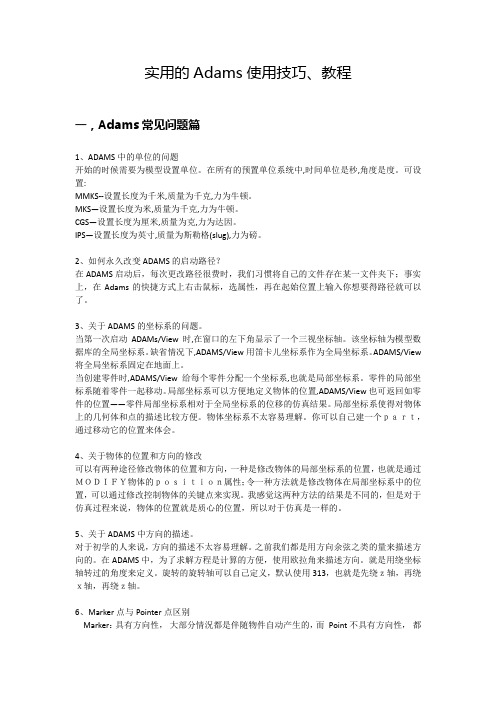
实用的Adams使用技巧、教程一,Adams常见问题篇1、ADAMS中的单位的问题开始的时候需要为模型设置单位。
在所有的预置单位系统中,时间单位是秒,角度是度。
可设置:MMKS--设置长度为千米,质量为千克,力为牛顿。
MKS—设置长度为米,质量为千克,力为牛顿。
CGS—设置长度为厘米,质量为克,力为达因。
IPS—设置长度为英寸,质量为斯勒格(slug),力为磅。
2、如何永久改变ADAMS的启动路径?在ADAMS启动后,每次更改路径很费时,我们习惯将自己的文件存在某一文件夹下;事实上,在Adams的快捷方式上右击鼠标,选属性,再在起始位置上输入你想要得路径就可以了。
3、关于ADAMS的坐标系的问题。
当第一次启动ADAMs/View时,在窗口的左下角显示了一个三视坐标轴。
该坐标轴为模型数据库的全局坐标系。
缺省情况下,ADAMS/View用笛卡儿坐标系作为全局坐标系。
ADAMS/View 将全局坐标系固定在地面上。
当创建零件时,ADAMS/View给每个零件分配一个坐标系,也就是局部坐标系。
零件的局部坐标系随着零件一起移动。
局部坐标系可以方便地定义物体的位置,ADAMS/View也可返回如零件的位置——零件局部坐标系相对于全局坐标系的位移的仿真结果。
局部坐标系使得对物体上的几何体和点的描述比较方便。
物体坐标系不太容易理解。
你可以自己建一个part,通过移动它的位置来体会。
4、关于物体的位置和方向的修改可以有两种途径修改物体的位置和方向,一种是修改物体的局部坐标系的位置,也就是通过MODIFY物体的position属性;令一种方法就是修改物体在局部坐标系中的位置,可以通过修改控制物体的关键点来实现。
我感觉这两种方法的结果是不同的,但是对于仿真过程来说,物体的位置就是质心的位置,所以对于仿真是一样的。
5、关于ADAMS中方向的描述。
对于初学的人来说,方向的描述不太容易理解。
之前我们都是用方向余弦之类的量来描述方向的。
ADAMS后处理--把Adams后处理的图片编辑的漂亮
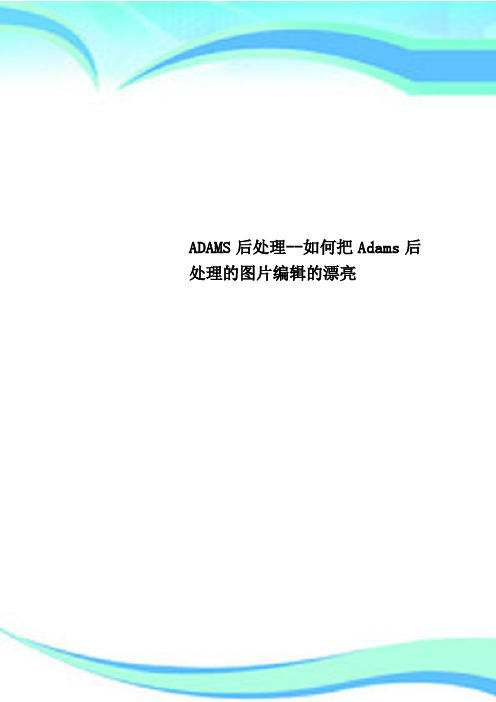
ADAMS后处理--如何把Adams后处理的图片编辑的漂亮
————————————————————————————————作者:————————————————————————————————日期:
学好挖掘机,完爆大学生!--Z——Y乾
1 横坐标如果要确定在某一个范围内:如下图所示
2 如何使坐标的字体变得大一些?
3 如何使背景变成虚线?
4 如何去掉右上角的legend?
5 如何使曲线变成表格的形式?
6 如何把图片的框框加粗并且改成其余颜色?
7 如何改变纵横坐标标示的大小?
8 如何改变横坐标的数字的字体、颜色和大小?
9 如何使背景的虚线更加疏或密?
10 如何改变legend里面的题目?
11 如何把图片导出?
进入postprocessor,file->print->进入print界面,点对话框中的file 单选按钮,native windows下拉列表中选jpg格式,ok,即可保存图片到工作目录下
然后在word中,插入-图片即可。
ADAMS软件使用技巧

ADAMS软件使用技巧【不断更新中……】(2010-03-18 16:23:35)转载分类:MSC标签:adams技巧心得教育声明:所有技巧来自网络收集、笔者个人经验,仅限于学习交流之用,帮助更多的人提高水平。
如果你有好的经验,欢迎添加到评论里面!一、提高ADAMS仿真速度可通过以下两个方法:1、可以把所有的Parts(尤其是柔性体)、Forces、Joints、Markers等等都设置为隐藏;2、取消仿真计算时的更新,即在Simulation Control对话框里取消勾选Update graphics display。
二、如何将ADAMS的处理结果曲线图保存为图片格式?FILE>>PRINT>>类型选IPG或者BMP,具体操作过程如下图所示:三、ADAMS-Car 中添加模版template系统盘的Documents and Settings目录下找到acar.cfg文件用记事本打开,把 ENVIRONMENT MDI_ACAR_USERMODE standard 修改为 ENVIRONMENT MDI_ACAR_USERMODE expert启动car模块,会看到可选模式有两种:标准模式standard和专家模式template builder四、同一台电脑上安装2007R3和2005R2成功安装2007R3和2005R2的软件,然后安装2007R3的许可即可。
原理就是高版本的许可适用所有MSC公司的产品。
而且两者可以同时打开,并不影响使用!五、检查模型:自由度,约束、驱动、冗余六、后处理adams/postprocessor界面下方或左方的工具栏没有了,从哪里可以导出?(经网友实践证明其可行)这个主要是ADAMS显示的问题,我以前遇到过,以为ADAMS出了问题,还重装过很多次。
后来偶然发现不需要重装就可以解决这个问题。
你只要试着将左侧或下方界面的区域拉大,就会重新显示出来的。
- 1、下载文档前请自行甄别文档内容的完整性,平台不提供额外的编辑、内容补充、找答案等附加服务。
- 2、"仅部分预览"的文档,不可在线预览部分如存在完整性等问题,可反馈申请退款(可完整预览的文档不适用该条件!)。
- 3、如文档侵犯您的权益,请联系客服反馈,我们会尽快为您处理(人工客服工作时间:9:00-18:30)。
学好挖掘机,完爆大学生!--Z——Y乾
1 横坐标如果要确定在某一个范围内:如下图所示
2 如何使坐标的字体变得大一些?
3 如何使背景变成虚线?
4 如何去掉右上角的legend?
5 如何使曲线变成表格的形式?
6 如何把图片的框框加粗并且改成其余颜色?
7 如何改变纵横坐标标示的大小?
8 如何改变横坐标的数字的字体、颜色和大小?
9 如何使背景的虚线更加疏或密?
10 如何改变legend里面的题目?
11 如何把图片导出?
进入postprocessor,file->print->进入print界面,点对话框中的file 单选按钮,native windows下拉列表中选jpg格式,ok,即可保存图片到工作目录下
然后在word中,插入-图片即可。
